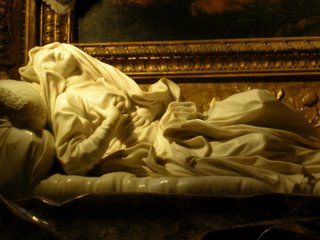Bernini's Chapels
Dear Signore Bernini,
I went back to the Cornaro Chapel this morning to study your Ecstasy of St. Teresa in more detail. I have to admit to you that I was extremely worried about this particular project. Certainly there was no better man for the job, however, the complexities of the situation surrounding this commission make it a dangerous task for any architect. I must say, though, that I am quite pleased with the finished product. In combining the death of St. Teresa with her most famous contact with our Lord, you have made this a very intimate statue. It is both startling and impressive, and again, as when I first saw it, I felt as though I was watching something private, and felt fortunate and honored to be privy to such a holy scene. Putting St. Teresa up above the churchgoers who will gaze upon her and setting the scene in the clouds helps to facilitate this feeling. There are many ways in which the Reformers who are trying so urgently to topple our way of worship could use the sainthood of Teresa against us. I thought it impossible, but you have shown the feasibility of use cold stone to convey the message of the Church in such a way as to encourage our children of God and at the same time avoid giving more ammunition to the Reformers. The way St. Teresa lays upon her back as though she had just been thrown there is ingenious. The ceaseless motion of her cloak shows her to be in the middle of the action of seeing her vision. She is defeated by the glory of God, unable to participate physically in her experience, able only to feel the love of God through the spear of the angel standing above her. The angel himself is a masterpiece. On his face worshipers will easily see his benevolent pity for Teresa. He holds his weapon with a grace that shows him to be divine, a messenger of God. Their union is obviously holy, in another realm out of the reach of the viewer.
You will of course have heard that your depiction of Teresa has already been criticized for her facial expression. I write to tell you that this does not worry me. Though some overeager reformers may find Teresa’s face and posture alarming and perhaps inappropriate, all I see is the most devotional of scenes. You have facilitated our arguments for the support of this controversial saint by making the lines of her body lost and invisible beneath her clothing, and her face lovely and pristine, but not feminine. She is hardly a woman at all, but rather a child of God experiencing a miracle. Those who gaze upon the statue will have no doubts as to its meaning. The depictions of learned men who look down upon the viewer from the sides of the chapel are also an ingenious touch. They peer through the walls, the interior of St. Peter’s behind them, showing their approval of the statue and therefore the support of the papacy. I assure you this assumed support is indeed there. The side figures will also show the pious who visit the chapel how they should react to the statue. The men are deep in discussion, obviously removed from the realm of St. Teresa and her angel. Those who see this example will know that they are to look upon and ponder the life of Teresa, but not emulate it. They are to witness the miracle and discuss it, but not expect the experience for themselves. The reformers can have no grievances with this piece.
Again congratulations and I hope your current projects are going well. May the peace of God be with you always,
Pope Innocent X
Dear Signore Bernini,
I thank you for finishing my great aunt Ludovica’s chapel in such a timely manner. I realize I did not offer you the grandest space in which to work, however the finished product has turned out beautifully. The statue itself is wonderfully intimate. It is a holy moment to depict, yet one can tell that it is an earthly situation. Ludovica is down on the level of the viewer, and a marble cloth at the front of the niche invites the onlooker into the scene. The way you took such a tall yet shallow area and placed the statue in the very bottom at first looked to me like a waste of precious space, not allowing enough emphasis to be placed on the main subject. But now I see the value of placing the experience of Ludovica in the realm of the witness. The extra space above serves a further function, making room for the wonderful painting of the Virgin, Child and
Sincerely,
Cardinal Albertoni



1 Comments:
A very creative and effective way to approach this assignment. You have outdone yourself - your references to the intricacies of the chapels, the goals of the Church in the post Counter Reformation, Teresa and her controversy, the artist and patron, all show that you were really listening in class that day (whew!)
I have a few small suggestions but will give them to you in person. Brava (again!)
Post a Comment
<< Home